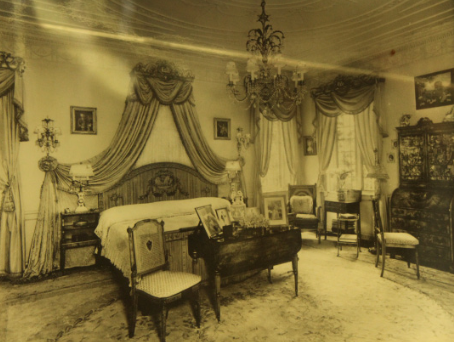By Paola Guzman
Copyeditor
Editors Note: The Pioneer learned after the publication of this story in last week’s issue that one of our sources had provided information to us that was not accurate. We have contacted the former university historian, Kenneth Mensing, who wrote and he has corrected those inaccuracies. The Pioneer apologizes to our readers. We always strive for accuracy in all of our work. Following is the correct version of “Landmark of the Week: The Mansion”.
The mansion is where it all started. Built from 1922 to 1929, the mansion has quite a rich history. For many years, it belonged to Marjorie Merriweather Post, daughter of Charles William Post of Post cereals. Kenneth Mensing, LIU Post’s former university historian, wrote a book titled “Hillwood: The Long Island Estate of Marjorie Merriweather Post.” Mensing contributed his research of over 20 years to the Pioneer.
Celebrities and royal families have walked through the mansion. Cars would enter through big red brick gates, located right across from Kumble Hall and the library. They would pass what is now Kumble Hall and drive up to a circular driveway. Stepping out of what would have been ostentatious cars of the 1920s, the guests would enter through the main entrance, which is now an entrance facing Roth Hall.
Every part of the mansion was built on-site. Instead of importing parts from around the world, the mansion was built entirely from scratch by Charles Mansfield Hart, an architect from Freeport, NY. Not many changes to the building have been made since then. Some of the woodwork, floorboards, doorknobs and windows remain from when the house was built. The mansion still has the majority of the original bricks made in a town called Post, Texas. founded by C.W. Post. Restoration of the mansion was possible due to Gary Winnick’s donations to restore the mansion from 2005 to 2008. Only a few individual bricks were moved from the Lower East Side to the mansion later from burnt tenement house buildings.
After entering the main entrance, guests were escorted to the living room, which is now the Great Hall. Unlike most mansions of the 1920s, this mansion’s living room was too small to be considered a ballroom for extravagant parties. It was a quiet place for Post to live in for about six months out of the year. Post used the mansion for charity parties, her daughter Dina Merrill’s wedding day, and after-parties.
In architectural terms, the Great Hall is faithful to a traditional great hall in England. Throughout the room there is imagery of ships, wild animals and hunting motifs carved into the woodwork. Marjorie’s second husband, E.F. Hutton, was a great sportsman. And when he decorated the room, he did so to reflect his tastes. They had large paintings of hunting scenes and animal heads on the wall. Above the piano there was a gigantic model of a ship called an English gallon that lit up. On either side of the Great Hall, there are two portraits, one of Marjorie Post, and the other of C.W. Post. Marjorie is was very fond of the portraits and she wanted to give a tribute to her father.
The andirons, metal supports that hold wood for a fireplace, standing in front of the replace in the Great Hall are original antiques from the house. The long table in the entryway was also acquired by the Post family and was used in their library. The large glass windows on either side of the replace boast the ancestral crests of Hutton and Post on the top, and commemorative lead glass added by the university, in the middle.
Moving into the hallway, leading to what is now a lobby connecting to the office of Alumni Relations and a staircase leading to the Philosophy Department, the wall and ceiling material change. The ceiling features plaster carvings that took about three months to make.
Walking further into the lobby, there is the “American bedroom,” which now houses the office of Alumni Relations. This room was used as a guest bedroom, and was occupied by famous names like Billie Burke and Florenz Ziegfeld. The wallpaper was hand-picked by Post, and hand-painted in the 18th century depicting George Washington’s inauguration.
Within that room is another room that used to be the guest bathroom. Different from the rest of the house’s extravagant walls, this particular wall in what used to be the guest bathroom is decorated with actual Christmas postcards sent to the Post family.
The staircase leading up the Philosophy Department and Honors College portrays detailed carvings of a hunting scene throughout the entire outside of the staircase. Its sharp details include animals and leaves of trees. The ceiling also features plaster carvings of flowers and garden imagery.
Dina Merrill’s bedroom and the nursery existed where the philosophy department is currently located. What is now the philosophy conference room used to be a sleeping porch/playroom for Post’s children. Across the hall, what is now the honors college classroom, was Hutton’s bedroom. Marjorie took the original pine wood and replace with her after she sold the estate. Hutton’s room connected to a dressing room which is now the honors computer lounge. And that connected to a sleeping porch which is now the office of Joan Digby, Director of the Honors College. That all eventually connected to Marjorie’s bedroom, which is now the honors lounge. The colors of the walls are the exact same colors used when Marjorie occupied the bedroom. In the far end of the bedroom is a door that leads to what used to be Post’s bathroom, featuring marble walls different from the rest of the house, which used to have fixtures made of gold. This is now an extension of the honors college offices.
What is now the English department, used to be the staff’s wing of the mansion. “She had maids that would make her maid’s bed because her maids were busy,” Mensing said. This renders a portrayal of Post’s generosity and personality. According to Mensing, Post said, “If I didn’t have my staff, I couldn’t live my life the way I do.”
After the sale of the property to LIU, Marjorie would come up to the campus and “almost cry because she was so happy to see all of you [the students] there learning.”




Be First to Comment